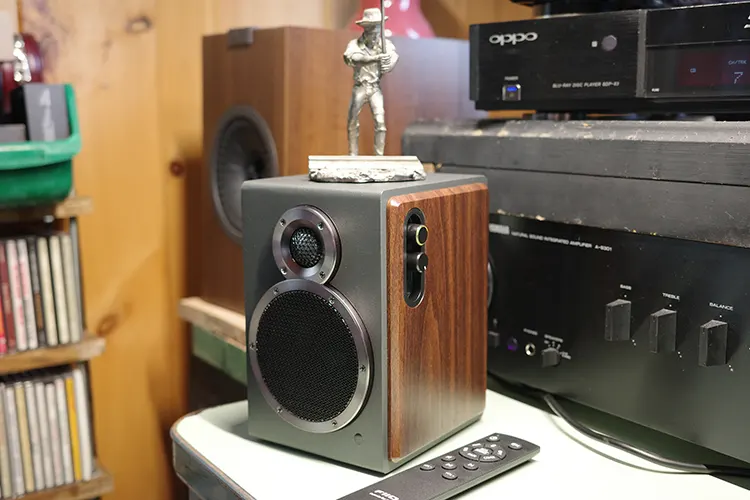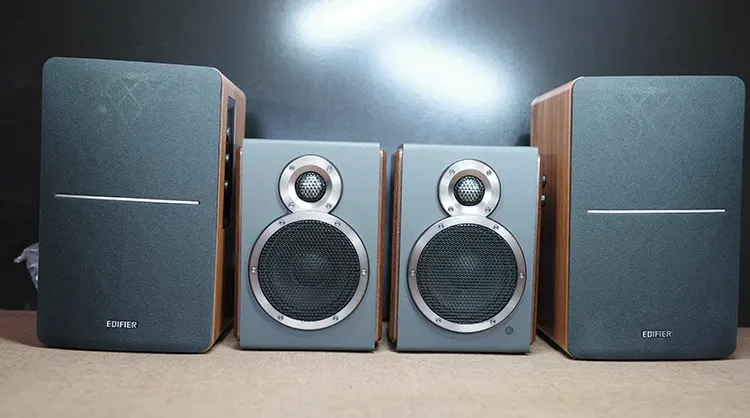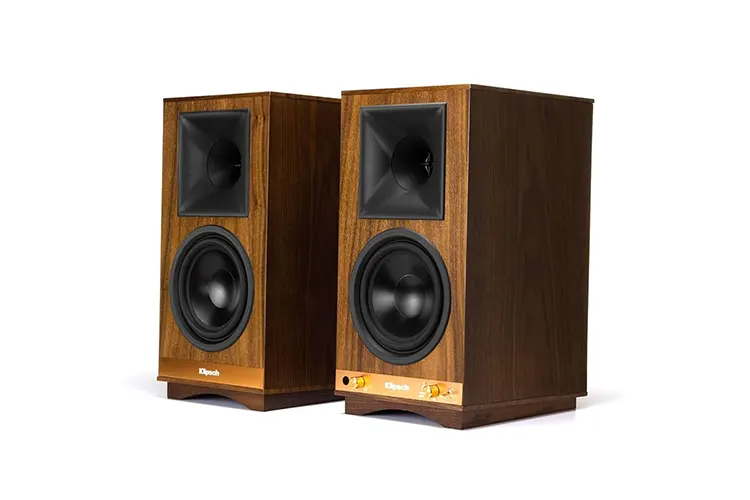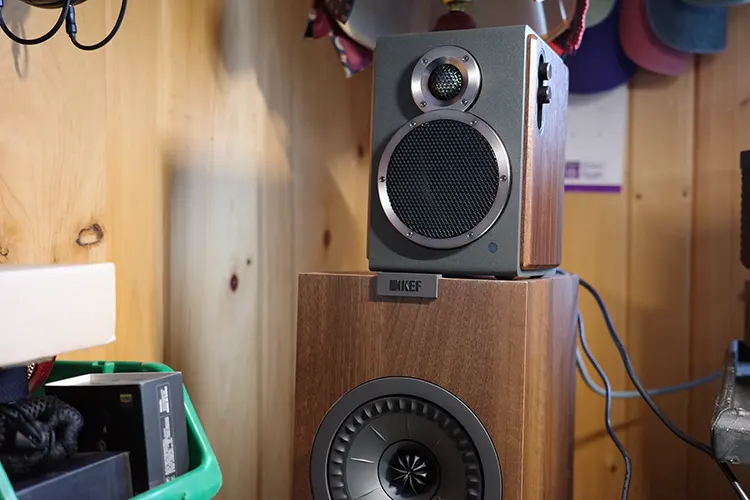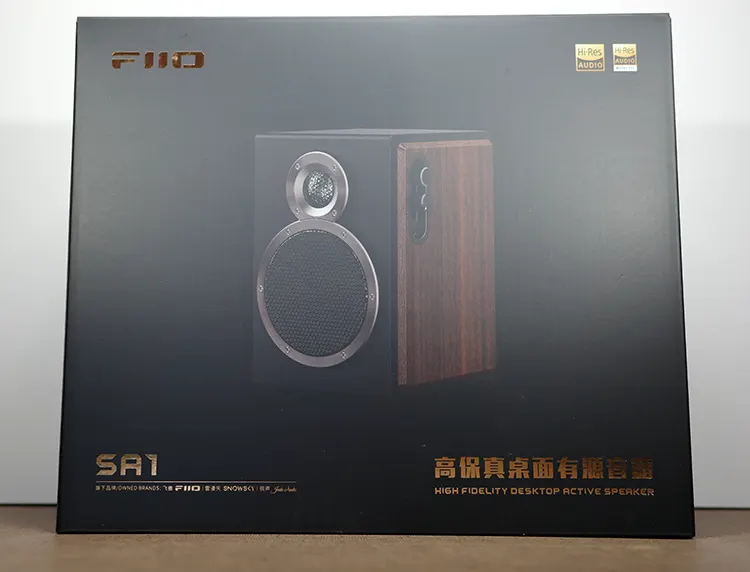Synergy
Efficiency
Yet again, there is only so much a small desktop speaker can provide to the listening atmosphere, and yet again, the FiiO surprised me with excellent quality.
The 3.5 kHz crossover works at the right point, allowing as much cooperation as possible between the two drivers. Sending the requisite power to each helps to keep control without stressing either. I wish the speakers were a bit more sensitive, but that is a minor fault.
Power
No matter the source, the FiiO SA1 has the ability to play at loud volumes. While not suitable for medium to large rooms, there is plenty of gusto for your desktop or small to medium room set-up.
This might be the perfect dorm room speaker that not only takes up little space but can make those who might scoff at it blush from the quality offered.
I did find I had to adjust the volume levels between sources, but this is normal. I quickly learned to turn down both the source and speaker volume when switching between sources.
I found the internal Texas Instruments power amplifiers to be quite sufficient for the SA1 and appreciated the extra headroom if needed.
Pairings
The first pairing used was with my iPhone 16 Pro Max, ensuring that all was well. After opening the app, I played a little bit with the controls but left them all neutral.
Tidal and Qobuz streaming came through with very good levels of detail, and Tidal added that extra thump down low like they do. For a modest setup, the duo functioned as expected.
Utilizing my MBP and Tidal gave a bit more low-end. While streaming through the MacBook, Tidal added a bit more bass response to the signature, but the sound makes for an excellent nearfield experience, especially when the speakers are at ear level.
The Audio-Technica BT TT connected seamlessly and provided good quality. I could even hear the pops and clicks of some older albums being played while listening. This would also make an excellent dorm room, or office set up, with all of the equipment placed out of the way or used as a nearfield again.
The same could be said about the FiiO TT13 paired both by RCA and BT. I did like the more neutral Audio Technica a bit more, but it also has a higher-level AT cartridge.
My favorite setup up though, was running either optical or coax from the Oppo BDP-83 as a CD transport.
I have used this setup in other reviews, such as desktop amplifiers and DACs, with success, and the pairing with the SA1 brought “old world” technology to the Oppo and CD quality to a desktop setup through the SA1.
The level of detail wrought from this pairing set itself apart from the rest, and it showed you really should hook the SA1s up to a variety of sources for the best flexibility and results.
Connectivity
Bluetooth
Connectivity to Qualcomm’s BT5.4 was quick and easy, once I determined that I had to use the “headphone” FiiO SA1 connection, not the other. Once done, the speakers remember which source they are connected to when turned off and will automatically reconnect.
Watching highlight and celebration clips from the Arsenal Women’s UWCL final against Barcelona, I found no latency and shed tears yet again for the ladies’ superb performance and victory. The SA1 performed admirably, just like the Arsenal women did.
WiFi
Tidal and Qobuz streamed effortlessly across the sources I used, either through BT or connected via the other input options, such as AUX-IN.
Wired
Playing CDs from the Oppo BDP-83 using the coax connection allowed for a good, small-space sound. Running both the Audio Technica AT-LP120XBT-USB and FiiO’s TT13 through both BT and RCA (with the SA1’s internal phono stage off) occurred without bother and as expected.
The optical-in was also used with the Oppo BDP-83, presenting similar results to the coax input.
Select Comparisons
Edifier R1280DBs
Features
The Edifier R1280DBs’s 4” midrange/bass driver is slightly larger than the SA1, while the 0.5” silk dome tweeter is smaller and made of a different material. Featuring a crossover (frequency undefined) like the SA1 makes for a smooth melding of sound across the spectrum.
With the same low signal-to-noise rate of +/-85dB and 55-20,000kHz the Edifier is quite similar, but reaches slightly deeper. Putting out 21W through each driver, the Edifier is slightly more powerful.
With optical, coax, and dual RCA inputs, the similarity continues. Dual RCA allows for connection to both a turntable (using the internal phono stage and a different source, which one-ups the FiiO.
The Edifier also carries an extra adjusting switch with both treble and bass adjusting knobs. Both function with more input than the FiiO. BT 5.1 rounds out the functionality.
Design
The wood veneer looks classy on the 146mm × 234mm × 196 mm-sized box, while the left speaker carries all of the electronics. The left speaker also carries more heft, clocking in at just under 11lbs and nearly 3x the SA1’s weight.
The slate gray faux metal on the front looks good enough to keep the grill off of each speaker, nearly matching the good looks of the FiiO. The bass port is more traditional as well, and ported out the front, helping to balance the differential size of the drivers.
Performance
The Edifiers are a budget-oriented BT speaker that follows on the heels of the R1280 model. Very good bass is wrought from the diminutive 4” woofer, with good depth and control coming forth.
It says a bit that the SA1 is only 0.5” less in diameter, but it cannot sound as deep. The size cavity plays into this, but conversely, the FiiO SA1 is eminently more placeable.
Without using either the treble or bass knobs, the Edifier sounds flat, with less life than I would like. The FiiO, on the other hand, sounds more lively, but with a smoothness that helps keep control.
The treble on the SA1 comes across with more depth to the notes and more sparkle. But not so much as to become brittle, but rather stay in control, giving better note weight and presence than the Edifier’s.
The mixing together of all three ranges comes across as more cohesive in the SA1, which says that even with its smaller size, it can come across in a much more engaging manner.
Add in that the Edifier needs more space to breathe and does not work as well on a smaller desktop, and the FiiO becomes even more impressive.
Klipsch The Sixes
Features
Not really a fair comparison, but I have owned this pair for close to five years, and use them regularly, besides testing. With a 6.5” long-throw woofer, the Klipsch follows the historical pattern of big low ends, but with purpose.
The bass port shoots out the back, so placing these much larger speakers can be a bit of a challenge. That port can be plugged with the included foam insert.
The 1” titanium tweeter shoots into the Tractrix horns, expanding treble output across a more 3D range. A subwoofer can be added, just like the SA1, but truthfully, one is not needed.
Putting out 100W (200W for short bursts), the Sixes are for much larger spaces but can be successfully utilized in smaller office setups. A frequency response of 40-20,000 kHz goes lower, too.
Design
The Sixes are much larger, coming in at 35 lbs each, and with a size comparable to a larger bookshelf speaker. While they work on the floor, lifting them approximately 12” is ideal.
The real walnut veneer carries the vintage look, as to the gold knobs and switches. The front knob allows for switching between inputs, and there is an on/off toggle. I worry about that toggle, as it could be easily broken off if the speaker is on the floor.
The grill is magnetic, and keeping it off allows the vintage look to exude elegance.
Inputs range from USB digital audio input, optical digital audio input, to Bluetooth 5.0 audio, to RCA stereo line level analog input, an auxiliary line level input, and an RCA phono level analog input. Lacking is the coax input of the SA1.
A fully functional remote helps to control inputs and volume, similar to the FiiO.
Aimed at a much higher category, the Sixes might seem well above the SA1s, but that should not be discounted, as mentioned below.
Performance
Having owned the Forte IIs since new, there is no denying the familial lineage to some historic Klipsch speakers between the two.
But this powered speaker forges its path at an excellent level. The bass and midrange come across as strong and with authority. Vocals are precise and persistent.
The FiiO tries their best and can hold their accomplishments up there with some of the benchmarks within their segment, which gives them hope across as many usages as the Klipsch, which should be applauded.
The treble from the Klipsch, while excellent, hit a bit more frontally for me than the FiiO. And this is where the FiiO does very well. Both carry a multi-metal tweeter, but the sound could not be more different.
Where the Klipsch hits frontal and is impactful, but spreads out nicely, the SA1s come across with a more toned-in sound that seems a bit tamed, but smooth. For a small near-field desktop speaker, the FiiO atones for itself very well.
KEF Q150
Features
The KEF Q150 is the mainstay speaker in my office setup, and as such, sees an immense amount of use. Even more than my main system. Paired with the budget-friendly Yamaha A-S301 amplifier, I can have many devices hooked to it, giving a good platform for judging sound.
A 1″ vented aluminum dome tweeter with waveguide is paired with the 5-1/4″ aluminum woofer uniquely. This Uni-Q® driver array technology creates a larger listening “sweet spot,” by placing the tweeter and woofer concentrically mounted together to create a single “point source” of sound.
KEF does this with their highest order speakers, too, and the results make for an excellent small space speaker.
The one panacea is that these are not very efficient to drive. They take a good amount of power to properly drive, which can hinder their use in some spaces.
Design
The walnut veneer is an excellent fit for office situations and as a secondary speaker. Set at 7-1/8″W x 11-15/16″H x 11-1/16″D and a little over 12lbs each, the Q150s are eminently placeable within your system. You can order speaker covers, but for an extra cost, I chose not to.
The speakers were best placed on a pedestal approximately 12” from each wall for my situation. The depth of each speaker does make for a bit of a tricky fit in small spaces, though.
The FiiO, on the other hand, can be placed without as much care, but time should be taken for the best sound capabilities.
Comparatively, the KEFs come across as equally subdued as the FiiO SA1 (in the color I have of each), which makes me appreciate the choices.
Performance
This isn’t a fair comparison either, but valid due to the closeness in pricing, currently. Due to current global pricing, the SA1 speakers are subject to increases, bringing the differential down even more.
Regardless, the two different usage characteristics make it interesting, to say the least. The KEF carries more and deeper bass due to the larger cabinet and woofer size, but in terms of quality, they are similar with tight control across the low-end.
The KEFs provide a better response and a deeper reach with a bit more decay, lengthening the note weight, which provides for a more grounded sound.
The midrange comes across with the liquidity KEF is known for, and somewhat unexpected at this level. The neutral character counters the elevated, more forward mids of the SA1.
The KEFs hit my sweet spot for both detail retrieval and musicality, but the FiiO atones itself nicely in this unfair comparison.
The top end of the KEFs is rolled off a bit, with a bit less sparkle than I would like, but this does allow for higher volumes. A more efficient or powerful amplifier might make for a more fervent treble note, but the KEFs come across as smooth, allowing the music to flow, whereas the SA1 adds a bit more extension.
Imaging is more even with the KEFs, lending a more equal spacing across the three dimensions as opposed to the extended height of the FiiO. Instrumentation is better in the KEFs as a result of that naturalness, portraying all three dimensions near-equally.
The KEF is a standard in the bookshelf segment, but the FiiO SA1 excels with more connective versatility and flexibility in its placement. Priced comparably, this makes for a valid comparison.
My Verdict
The FiiO SA1 nearfield desktop speakers are an interesting set. While they perform admirably as a nearfield, the speakers let you know when they have moved past their comfort zone. Moving beyond a medium-sized room does not benefit their preferences.
Used as a desktop speaker, the SA1s are also less prone to potential placement issues. I found the pair worked best with the tweeter at ear level, but also appreciated the sound coming forth from straight desktop levels.
The degree of spaciousness coming from the soundstage shows that either of these is among its best locations. A wedge can successfully orient the speakers up a bit as well.
Moving to a larger or more open setting, the FiiO struggled to compete with dedicated bookshelf speakers as expected. But the pair did an admirable job in fulfilling most of your wishes in terms of performance.
The bass is, as expected, a weakness, but that can be corrected by adding a comparable subwoofer. Just make sure the potential crossover is set such that you do not get any mistimed music (latency) between the pairing.
The best part of the app is the PEQ abilities, but this should be used in close conjunction with the placement of the speakers.
Other than that, the app is lacking in my book, and to move back from the custom settings, you need to exit the app, at least in my experience. But for the PEQ, it is quite good.
Used in appropriate situations, the FiiO SA1 is a proper nearfield or desktop speaker. Whatever shortcomings it has can be overlooked due to the excellent sonics wrought from those intimate settings and should be highly considered in this category.
FiiO SA1 Technical Specifications
- Product Type: Desktop speaker
- Cabinet Material: High Density MDF
- Color: Twilight black, Cloud white, Mahogany
- Dimensions: Main Unit: 135.5×155.6x185mm (including feet), Secondary Unit: 129×141.6x185mm (including feet)
- Weight: Main Unit: 1750g, Secondary Unit: 1660g
- Bluetooth codec support: LDAC/AAC/SBC
- Bluetooth version: 5.4
- Speaker crossover: Two-way active electronic, crossover point at 3.5 kHz
- Driver size: Woofer: 3.5”, Tweeter: ¾”
- Diaphragm material: Woofer: Wood fiber cone, Tweeter: Aluminum-magnesium alloy diaphragm
- Frequency response: 65- 20 kHz
- Power output: Woofer: 20 W*2, Tweete:r 5 W*2
- Bass adjustment: -6dB-0dB
- Inputs: RCA/PHONO IN, AUX IN, USB IN, COAX IN, OPTICAL IN
- Output: Subwoofer output (SUB OUT)
- Signal input indicators: Sky blue: RCA, Pink: PHONO, Green: AUX, Purple: Optical, Yellow: Coax, Orange: USB, Blue: Bluetooth.
- Bluetooth indicator: Lights flash red and blue when not connected in Bluetooth mode, the light will stay blue after successful pairing and connection in Bluetooth mode.
- USB/Optical/Coaxial support: USB: 96k/32bit, Coaxial: 192k/24bit, Optical: 96k/24bit


